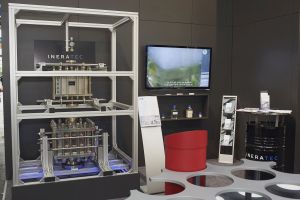The representatives of Karlsruhe Institute of Technology (KIT) were doubly blessed when the Baden-Württemberg Environmental Technology Award 2017 was conferred yesterday. Among others, two projects conducted in cooperation with KIT were awarded a prize by Franz Untersteller, Minister of the Environment. SOLINK combines photovoltaics and solar thermal technology in an efficient tandem collector. INERATEC, a spinoff of KIT, develops compact chemical reactors for the production of sustainable chemicals and fuels.
“Thanks to the innovation efforts at KIT, we are able to bridge the gap between theoretical scientific insight and its practical application,” Professor Thomas Hirth, Vice President for Innovation and International Affairs at KIT, explains. “We want to be innovative – for the benefit of society, economic prosperity, and the preservation of our natural resources. The fact that the Environmental Technology Award considers two technologies for which we have been a driving force is very encouraging for us.”
The first prize of the Baden-Württemberg Environmental Technology Award 2017 in the “Energy Efficiency” category was awarded for the photovoltaic-thermal energy supply unit SOLINK. Using an air-air heat exchanger, the tandem collector combines photovoltaics and solar thermal technologies into a supply unit for heat pumps. While the top side of the novel collector uses photovoltaics to produce electric current, the bottom side generates thermal energy for heat pumps. An easy-to-fit connector system ensures the electric and thermal connections of the so-called PVT collectors so that they use the same roof surface for two purposes alike. Their market launch by the industry partner, Consolar Solare Energiesysteme GmbH, is scheduled for 2018.
The concept relies on preliminary studies conducted over many years in cooperation with the Karlsruhe Institute of Technology and funded by the German Federal Government and the German Foundation for the Environment. Andreas Wagner from the Building Science Group at KIT applied computer simulation to optimize the generation of energy by PVT collectors. For this purpose, he compared different configurations of module sizes, heat flow, and load shifting. Besides, he and his team used total absorption costing to calculate the efficiency of the concept. Bodo Ruck, head of the Building and Environmental Dynamics working group at KIT, was also involved for the consideration of air flows relevant to the heat transfer in the system.
Find more information here:
https://fbta.ieb.kit.edu/182_830.php
The third prize in the “Emission Reduction, Treatment and Separation” category went to INERATEC GmbH, a spinoff of KIT. INERATEC develops and sells microstructured, compact chemical reactors that convert green house gases into chemicals and synthetic fuels. Microsystem facilities are a promising trend when designing energy and material efficient methods in process engineering. The presented method uses the Fischer-Tropsch synthesis to produce synthetic fuels. Due to the compact system design, no complex components are required, the start-up and shutdown procedures are faster, and there are no excess process gases that need to be flared off. The technology developed by INERATEC is currently also used in Finland to convert hydrogen obtained from solar energy and carbon dioxide extracted from air into liquid fuels.
Find more information here:
http://www.kit.edu/kit/pi_2016_156_power-to-liquid-erste-kompaktanlage-im-pilotbetrieb.php
About the Environmental Technology Award:
Every two years, the Baden-Württemberg Ministry of the Environment, Climate Protection and the Energy Sector grants the Baden-Württemberg Environmental Technology Award. The award honors outstanding and innovative products and methods in environmental technology. Unlike the Environmental Award conferred by the Ministry since 1993, the Environmental Technology Award targets products or methods and their particular technological efficiency for the benefit of the environment rather than in-house processes. The prize money amounts to EUR 100,000 and is spread over four categories, “Energy Efficiency”, “Material Efficiency”, “Technologies for Emission Reduction, Treatment and Separation”, and “Measurement and Control Technology, Industry 4.0”, and a special prize of the jury.
In close partnership with society, KIT develops solutions for urgent challenges – from climate change, energy transition and sustainable use of natural resources to artificial intelligence, sovereignty and an aging population. As The University in the Helmholtz Association, KIT unites scientific excellence from insight to application-driven research under one roof – and is thus in a unique position to drive this transformation. As a University of Excellence, KIT offers its more than 10,000 employees and 22,800 students outstanding opportunities to shape a sustainable and resilient future. KIT – Science for Impact.

